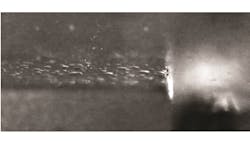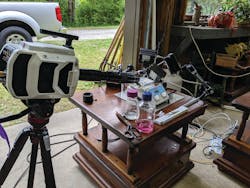High-speed camera assists in solid-state battery research
All batteries include an anode and cathode, which in traditional lithium-ion batteries, exchange lithium ions through a liquid electrolyte. The electrolyte passes through a porous separator, preventing contact between the two electrodes. Solid-state batteries integrate a solid electrolyte membrane—generally a polymer or glass/crystalline-type ceramic—that allows ions to move freely throughout the solid matrix. Instead of suspending the anode and cathode in liquid, solid-state batteries layer the anode, cathode, and electrolyte, which saves space without compromising charge. By avoiding the toxic, flammable liquid electrolytes, solid-state batteries offer a safer alternative. Additionally, the batteries have a higher charging capacity over liquid options.
Postdoctoral student Dr. Zachary Hood, at MIT (Cambridge, MA, USA; www.mit.edu) recently joined Argonne National Laboratory’s (Lemont, IL, USA; www.anl.gov) Applied Materials Division and is among those researchers looking to develop new materials and architectures for such solid-state battery systems. To advance his work, Hood partnered with Vision Research (Wayne, NJ, USA; www.phantomhighspeed.com) to observe thin film deposition—a manufacturing method for thin-film solid-state battery technologies—at micro temporal and spatial resolutions.
Thin film lithium-ion batteries are an emerging type of solid-state technology in which all components—anode, cathode, and electrolyte—are deposited in micrometer-thick layers on a substrate. Battery manufacturing involves using thin film deposition techniques like spray pyrolysis, which involves spraying a material onto a heated surface, where the droplets undergo thermal degradation in response to the heat and leave behind a thin film. Researchers have previously not observed the process by which the spray droplets deposit the solid electrolyte onto the heated surface during pyrolysis, at least not at high spatial and temporal resolutions, explains Kyle Gilroy, Applications Engineer, Vision Research.
To accomplish this, Hood and Gilroy set up a Phantom v2512 high-speed camera coupled with an advanced microscopy lens to record thin film deposition. This camera features a proprietary 1 MPixel CMOS image sensor and reaches 25,700 fps at full resolution and up to 1,000,000 fps at 256 x 32 resolution. It also offers a 28 µm pixel size with high sensitivity to light and 12-bit depth that achieves 4,096 grey levels – providing researchers the ability to decipher subtle motion details. Furthermore, the camera has 72, 144, or 288 GB RAM memory, 10Gb Ethernet interface, and 265 nanosecond minimum exposure time, which reduces motion blur and enables the capture of precise images of the fast moving micro-droplets.
With a single-crystal magnesium oxide substrate serving as the heated interface, the duo calibrated images using a transparent 50 µm microchannel that has a known width. Knowing the width of the channel enabled them to get a calibration of XX microns/pixel for each of the videos. For example, calibrating the images produces a number representing XX µm per pixel. If XX is 10 µm per pixel and the object in the image is 2 pixels large, the object is actually 20 µm. Because high-speed images require adequate illumination, high-intensity LEDs set at 100% illumination provided back lighting.
Frame rates, exposure times, and resolutions varied across the experiments and included the following shots: 31,000 fps at 1024 x 768 resolution (3 microseconds exposure time), 68,000 fps at 1152 x 320 resolution (1 microsecond exposure time), and 110,000 fps at 1152 x 192 resolution (2 microseconds exposure time). Analysis of the high-speed video shows that micro-droplets either combine with the hot surface or reduce in size and float off as smaller droplets to deposit elsewhere. Based on these experiments, Hood concludes that the interaction between droplets and hot surface is highly complex, and as a result, lays the foundation for further research.
About the Author

James Carroll
Former VSD Editor James Carroll joined the team 2013. Carroll covered machine vision and imaging from numerous angles, including application stories, industry news, market updates, and new products. In addition to writing and editing articles, Carroll managed the Innovators Awards program and webcasts.

